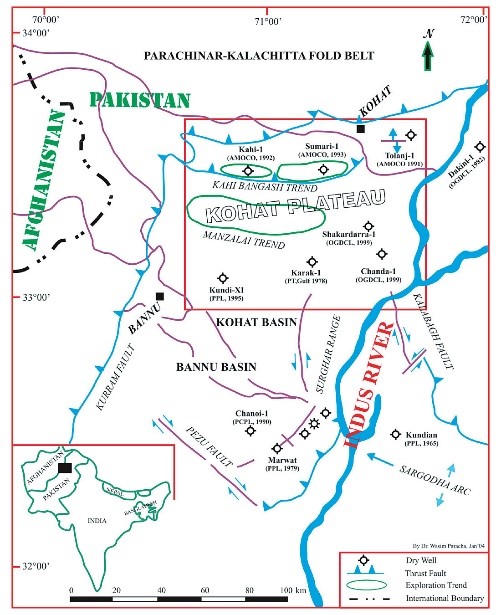Thermal Energy Estimation by In-situ Combustion in An Abandoned Oil Well
Abstract
A downside of producing oil is that it can never be fully recovered. After the end of a well's life span, the residual oil remaining in the reservoir on average can be over 30%. This residual oil can be extracted using enhanced oil recovery techniques, one of which combusts the oil in the formation where the average reservoir temperature can increase to 400⁰C for light oil and over 600⁰C for heavy oils. This method can become a significant catalyst in solving Pakistan's energy need and increasing power production. This paper aims to estimate the thermal energy production by combusting this residual oil using in-situ combustion by air injection technique. The study deals with the well Kahi-01 located in the upper Indus basin having three formations. The main target is the Hangu formation and its three reservoir blocks. This formation is characterized by its high residual oil percentage of 76-85% at depths of about 1691-1741 meters. The results show that the highest thermal energy output among the three reservoirs was 34.6e6 Megajoules. The highest power output from the binary plant was 38.5e4 Kilowatt hour.
Full text article
References
Ferizal, F. H., Netzhanova, A. A., Lee, J., Bae, W., Am, S., & Gunadi, T. A. (2013, June 11). Revitalizing Indonesia’s Potential for Oil Production: The Study of Electromagnetically Heated Gravel Packs for Steam-produced Heavy Oil Reservoirs. SPE Heavy Oil Conference-Canada. https://doi.org/10.2118/165508-MS DOI: https://doi.org/10.2118/165508-MS
Hart, A. (2014). The novel THAI–CAPRI technology and its comparison to other thermal methods for heavy oil recovery and upgrading. Journal of Petroleum Exploration and Production Technology, 4(4), 427–437. https://doi.org/10.1007/s13202-013-0096-4 DOI: https://doi.org/10.1007/s13202-013-0096-4
Hidayat, F., & Abdurrahman, M. (2018). A Prospective Method to Increase Oil Recovery in Waxy-Shallow Reservoir. IOP Conference Series: Materials Science and Engineering, 306(1). https://doi.org/10.1088/1757-899X/306/1/012040 DOI: https://doi.org/10.1088/1757-899X/306/1/012040
Kiijarvi, J. (2011). Darcy Friction Factor Formulae in Turbulent Pipe Flow. Lunowa Fluid Mechanics Paper, 110727.
Kusumastuti, I., Erfando, T., & Hidayat, F. (2019). Effects of Various Steam Flooding Injection Patterns and Steam Quality to Recovery Factor. Journal of Earth Energy Engineering, 8(1), 33–39. https://doi.org/10.25299/jeee.2019.vol8(1).2909 DOI: https://doi.org/10.25299/jeee.2019.vol8(1).2909
Li, K., & Zhang, L. (2008). Exceptional Enhanced Geothermal Systems from Oil and Gas Reservoirs. Stanford University, 43rd Workshop on Geothermal Reservoir Engineering.
LIAO, G., WANG, H., WANG, Z., TANG, J., WANG, B., PAN, J., YANG, H., LIU, W., SONG, Q., & PU, W. (2020). Oil oxidation in the whole temperature regions during oil reservoir air injection and development methods. Petroleum Exploration and Development, 47(2), 357–364. https://doi.org/10.1016/S1876-3804(20)60052-0 DOI: https://doi.org/10.1016/S1876-3804(20)60052-0
Mehmood, A., Yao, J., Yan Fun, D., & Zafar, A. (2017). Geothermal Energy Potential of Pakistan on the Basis of Abandoned Oil and Gas wells. Journal of Petroleum & Environmental Biotechnology, 08(03), 3. https://doi.org/10.4172/2157-7463.1000332 DOI: https://doi.org/10.4172/2157-7463.1000332
Melysa, R. (2016). Prediksi Kinerja Steamflood Dengan Metode Myhill-Stegemeier dan Gomaa di Area R Duri Steamflood (DSF). Journal of Earth Energy Engineering, 5(2), 44–56. https://doi.org/10.22549/jeee.v5i2.478 DOI: https://doi.org/10.22549/jeee.v5i2.478
Mulyanto, B. S., Dewanto, O., Yuliani, A., Yogi, A., & Wibowo, R. C. (2020). Porosity and permeability prediction using pore geometry structure method on tight carbonate reservoir. Journal of Physics: Conference Series, 1572(1). https://doi.org/10.1088/1742-6596/1572/1/012052 DOI: https://doi.org/10.1088/1742-6596/1572/1/012052
Nemati Zadeh Haghighi, A., Dabiri, A., Azdarpour, A., & Karaei, M. A. (2019). Oxidation behavior and kinetics of Iranian crude oil samples using thermal analysis (TA). Energy Sources, Part A: Recovery, Utilization and Environmental Effects. https://doi.org/10.1080/15567036.2019.1698676 DOI: https://doi.org/10.1080/15567036.2019.1698676
Paracha, W. (2004, April). kahi location.pdf. Recorder, 29(04), 12.
Røksland, M., Basmoen, T. A., & Sui, D. (2017). Geothermal Energy Extraction from Abandoned Wells. Energy Procedia, 105(1876), 244–249. https://doi.org/10.1016/j.egypro.2017.03.309 DOI: https://doi.org/10.1016/j.egypro.2017.03.309
Saddique, B., Ali, N., Jan, I. U., Hanif, M., Shah, S. A., Saleem, I., Faizi, M. M., & Arafat, M. Y. (2016). Petrophysical analysis of the reservoir intervals in kahi-01 well, Kohat Sub-Basin, Pakistan. Journal of Himalayan Earth Sciences, 49(1), 30–40.
Shakeel, S. R., Takala, J., & Shakeel, W. (2016). Renewable energy sources in power generation in Pakistan. In Renewable and Sustainable Energy Reviews (Vol. 64, Issue 64, pp. 421–434). https://doi.org/10.1016/j.rser.2016.06.016 DOI: https://doi.org/10.1016/j.rser.2016.06.016
Srivastava, S., & Teodoriu, C. (2018). Gas Well Conversion To Geothermal : A Case Study For Oklahoma. Gas Well Conversion To Geothermal : A Case Study For Oklahoma, 1–9. https://doi.org/SGP-TR-213
Thomas, S. (2008). Enhanced oil recovery - An overview. Oil and Gas Science and Technology, 63(1 SPEC. ISS.), 9–19. https://doi.org/10.2516/ogst:2007060 DOI: https://doi.org/10.2516/ogst:2007060
Tian, X., Liu, C., & Li, K. (2018). Modeling of Geothermal Power Generation from Abandoned Oil Wells Using In-situ combustion Technology. Standford Geothermal Workshop.
Ur Rehman, S. A., Cai, Y., Siyal, Z. A., Mirjat, N. H., Fazal, R., & Kashif, S. U. R. (2019). Cleaner and sustainable energy production in Pakistan: Lessons learnt from the Pak-times model. Energies, 13(1), 1–21. https://doi.org/10.3390/en13010111 DOI: https://doi.org/10.3390/en13010111
Yuan, C., Emelianov, D. A., Varfolomeev, M. A., & Abaas, M. (2019). Combustion behavior of aromatics and their interaction with n-alkane in in-situ combustion enhanced oil recovery process: Thermochemistry. Journal of Industrial and Engineering Chemistry, 76, 467–475. https://doi.org/10.1016/j.jiec.2019.04.014 DOI: https://doi.org/10.1016/j.jiec.2019.04.014
Zhu, Y., Li, K., Liu, C., & Mgijimi, M. B. (2019). Geothermal power production from abandoned oil reservoirs using in situ combustion technology. Energies, 12(23). https://doi.org/10.3390/en12234476 DOI: https://doi.org/10.3390/en12234476
Authors
This is an open access journal which means that all content is freely available without charge to the user or his/her institution. The copyright in the text of individual articles (including research articles, opinion articles, and abstracts) is the property of their respective authors, subject to a Creative Commons CC-BY-SA licence granted to all others. JEEE allows the author(s) to hold the copyright without restrictions and allows the author to retain publishing rights without restrictions.




